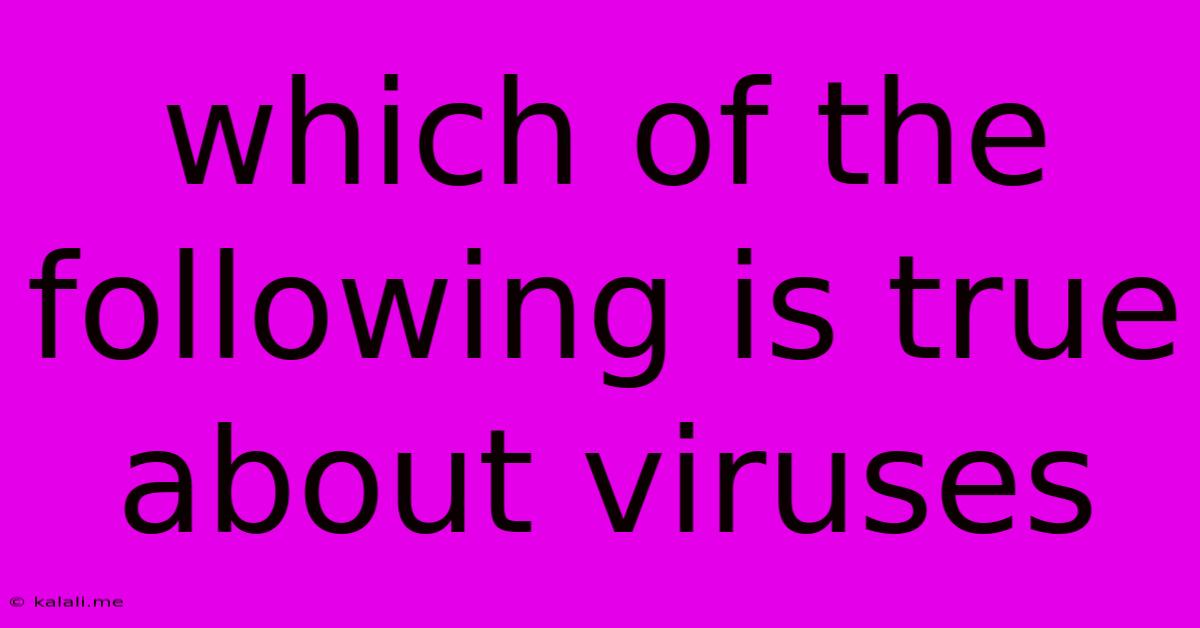Which Of The Following Is True About Viruses
Kalali
Jun 16, 2025 · 3 min read

Table of Contents
Which of the following is true about viruses? Deconstructing Viral Characteristics
Viruses are fascinating and often misunderstood entities. They blur the line between living and non-living things, leading to much debate about their classification. This article will explore several common statements about viruses and determine which are accurate reflections of their unique characteristics. Understanding the true nature of viruses is crucial in combating viral infections and developing effective treatments.
What are viruses? Before diving into the true/false statements, let's establish a basic understanding. Viruses are incredibly small infectious agents that replicate only inside the living cells of other organisms. They lack the cellular machinery necessary for independent reproduction, relying entirely on their host cells for survival and propagation. This parasitic nature is key to understanding their behavior.
Now, let's examine some common assertions about viruses and determine their validity.
Statement 1: Viruses are alive.
FALSE. While viruses exhibit some characteristics of living organisms, such as the ability to reproduce (albeit indirectly), they lack many others. Crucially, they lack cellular structure, the ability to metabolize independently, and the capacity for self-replication outside a host cell. These fundamental traits typically define life, and viruses do not possess them. Therefore, viruses are generally considered to be non-living infectious agents. They occupy a unique space on the biological spectrum.
Statement 2: Viruses are always harmful.
FALSE. While many viruses cause diseases in humans, animals, and plants, not all viruses are pathogenic. Some viruses exist in a commensal relationship with their hosts, meaning they coexist without causing harm. Furthermore, bacteriophages – viruses that infect bacteria – are being actively researched for their potential use in combating bacterial infections, particularly antibiotic-resistant bacteria. This demonstrates the potential for beneficial applications of certain viruses. The study of these beneficial viruses is a growing field in virology and biotechnology.
Statement 3: Viruses contain both DNA and RNA.
FALSE. Viruses typically contain either DNA or RNA, but not both. The genetic material of a virus is encoded in either deoxyribonucleic acid (DNA) or ribonucleic acid (RNA), never both simultaneously. This distinction is crucial in viral classification and determining the replication strategy of the virus. The type of nucleic acid present dictates how the virus hijacks the host cell's machinery.
Statement 4: Viruses can be treated with antibiotics.
FALSE. Antibiotics are specifically designed to target bacterial cells. Because viruses lack the cellular structures targeted by antibiotics, these medications are ineffective against viral infections. Instead, antiviral medications are used to treat viral infections; these drugs work by targeting specific aspects of the viral life cycle, such as replication or entry into host cells. Understanding this difference is crucial in treating infectious diseases effectively.
Statement 5: Viruses can evolve and mutate.
TRUE. This is one of the most challenging aspects of combating viral infections. Viruses have high mutation rates, allowing them to adapt quickly to new environments and hosts. These mutations can lead to the emergence of new viral strains that are resistant to existing treatments or vaccines, highlighting the dynamic and ever-changing nature of viruses. This rapid evolution is a major driver of pandemic outbreaks and necessitates ongoing surveillance and research.
In conclusion, while often perceived as simply harmful agents, viruses represent a complex and fascinating area of biological study. Their unique characteristics, including their non-living nature, varied effects on hosts, and remarkable capacity for evolution, highlight their significant influence on the biosphere. Understanding the accurate statements about viruses is essential for advancements in viral research, disease prevention, and the development of effective treatments.
Latest Posts
Latest Posts
-
How To Create Clickable Image In Html
Jun 16, 2025
-
What Are The Factors Of 121
Jun 16, 2025
-
What Is A Theme Of The Passage
Jun 16, 2025
-
A Company That Provides Access To The Internet
Jun 16, 2025
-
Which Word Is Closest In Meaning To The Underlined Word
Jun 16, 2025
Related Post
Thank you for visiting our website which covers about Which Of The Following Is True About Viruses . We hope the information provided has been useful to you. Feel free to contact us if you have any questions or need further assistance. See you next time and don't miss to bookmark.